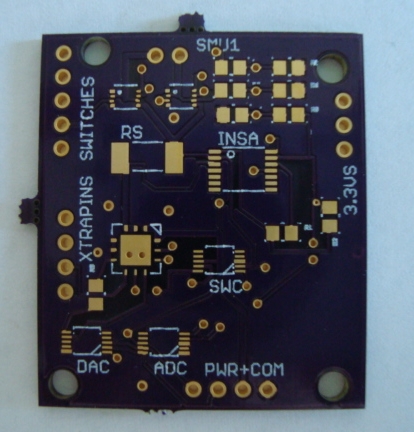Blog
Eye-candy!
Hi All,
Our case prototypes are looking good! Check out the pictures!
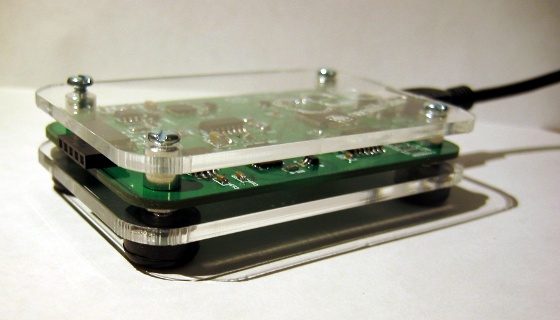
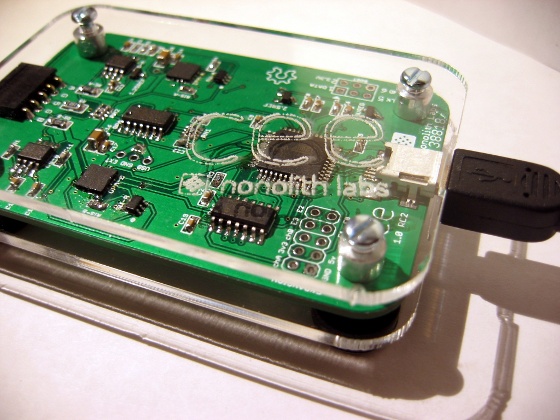
Production-ready!
Good news, everyone!
Our latest prototype revision is assembled and tested, and we think they're good to go. We're moving full speed ahead with production.
We're making a few cosmetic changes on our final boards, buying parts, ordering boards, documenting code, and finishing up our user interface. It's looking like your CEEs will be in your hands in January!
For those of you interested, we've included a picture of our RC1 and RC2 boards side-by-side.
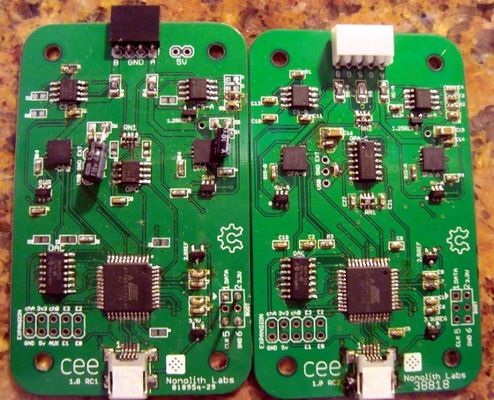
Revised Board!
We've made a handful of changes to make the CEE easier to calibrate and more robust to use. Channel-specific current limits, required to keep the CEE operating safely off your computer's power, are now independently calibratable. The "measurement" part of the CEE is now fully buffered - we added an extra bit of analog circuitry to greatly increase the CEE's ability to measure tiny signals, like those generated from thermocouples and photodiodes.
We'll be ordering the next round of prototype boards tomorrow and they should be in hand in approximately ten days. Firmware and PC-side software development are continuing in parallel with hardware revisions.
We're hoping that this will be the last revision of boards before we start production.

Progress, Prototypes, and Production
Our latest iteration CEEs are fully working! There's room for optimization, but our prototypes have charged cellphone batteries, measured light intensity with a photodiode, driven electromagnets, and characterized the voltage/current behavior of a lemon battery.
The out-of-the-oven precision and accuracy of our CEEs has been thoroughly encouraging. We're hard at work on digital post-processing and calibration routines to ensure that what you see on your computer is what's happening in the real world.
The design for the laser-cut case and the list of nuts and bolts is nearing finalization, with steps being taken to ensure that the CEE is ready to go when you open your box and as hackable as possible.
With the short list of optimizations we've assembled, we suspect that our next round of boards, "release candidate 2" boards, will be production-ready. Those of you who ordered bare PCBs can expect to have your reward in-hand by the end of the year. With final tweaks and verification, then manufacturing leadtime, those of you who ordered CEEs will be receiving them very early 2012.
Remember to check our Twitter feed and our development site for up-to-the-minute progress reports. Within the next few days we'll be posting some "action shots" of our prototypes, some sample code for an early API, and some waveforms showing off the potential of the CEE.

Thanks!
We posted earlier about a depressing evolution in our shipping timeline. Since then, people have come through for us, and our main chips are in hand. Major props to April at NuHorizons, John at Atmel, and Cheryl at SemiTech.
We don't have super-spectacular unboxing pictures due to a desire to not spoil the moisture-sensitive chips, but we have a couple of big silver bags containing a few hundred ATXMEGAs.
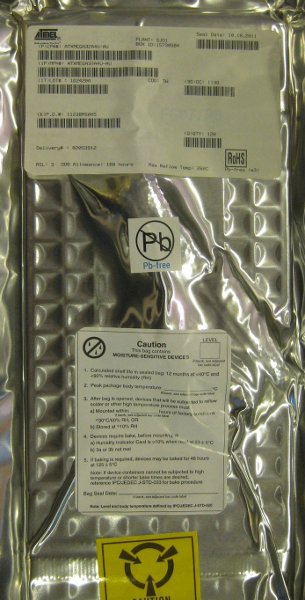
Board Revision & Software Update
Our next round of prototype boards are in production! We've made a ton of changes to make the CEE more robust, easier to hand-assemble, and more functional.
We've completely reworked the measurement side of the CEE to fix a design issue with our first round of boards, we've moved to a bigger version of our digital-to-analog converter, making the CEE easier to build, and we've added a standard six-pin programming port, such that the firmware can be loaded with a standard Atmel programming cable.
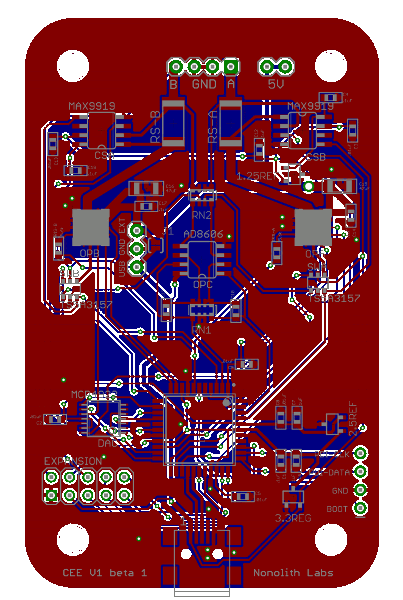
In parallel with reworking the circuit board, we've made significant progress in improving the capabilities and efficiency of the software on the computer side of the USB cable.
We have our beta hardware returning 100k samples per second, and a first-pass analysis of the data indicates that it's both a precise and accurate representation of what's actually going on. We're currently working on getting output functioning at the same rate.
Kevin's been making great strides in adding extremely fast WebGL rendering to our Pixelpulse web frontend, giving even moderate hardware running an up-to-date version of Chrome or Firefox the ability to handle all the data you can throw at it.
We'll post again when we have bidirectional information moving at 100KHz and when our next round of prototypes are assembled.
PermalinkMoving Right Along
Hi All!
We've been coding and debugging like crazy and have been met with great success.
The beta version of the CEE has been progressing nicely.

Our prototypes demonstrate good accuracy and precision, despite not yet being calibrated.


We've already used our early stage prototypes to debug themselves

talk to motors

and control temperature.

We've turned up a number of ways to improve this prototype and hope to have a release candidate board design out for fabrication by the end of next week.
As always, keep an eye on our development repository and Twitter feed for up to the minute info as we continue development.
Best!
Ian and Kevin
Nonolith Labs
PCB Pictures and Timeline Update
Hi All!
Apologies for the radio silence. Here's a window into what's new in Nonolith Labs.
Our alpha PCBs are in, and they look great. If you missed the twitter post , check it out.

We have a prototype half-assembled, with the parts on hand to build everything. Taking babysteps to help with debugging.

In other news, we have an order for 350u of the ATXMEGA32A4U in the books! Early on, we elected to switch from the LPC1343 to the XMega32A4U. The switch allowed us to majorly crank up the speed of our CEE and produce a more svelte product with fewer hacks. The XMega is a brand new part, but we got enough samples to know that they existed and met most of our expectations. We were wary of supply-chain issues, as Atmel's had some problems in the past, but our rep assured us that the problems had been resolved. At the time of our last post, he had lead us to believe that the chips would be available within "a few weeks." We took it for granted, and kept along with our development process and put our nose to the grindstone with business matters.
After the chips didn't show up online, we got antsy and got back in touch with our rep. Things didn't look good, and we spent some time exploring other options. Turns out, nothing out there can match this chip when it comes to USB throughput or ADC quality. We now have an order on the books, with a twelve week leadtime. Not quite "a few weeks," but we'll take it.
The bad news - between the twelve weeks for the chips and the five weeks for manufacturing, we're looking at shipping in about four and a half months. Our design is on track to be production-ready in well under the quoted leadtime and our supplier suspects that the leadtime can be expedited. We have high hopes for shipping sooner, but we've learned the value of caution. Those of you who ordered boards are in luck - we'll be shipping those as soon as our design is finished and verified.
On a related note, Kevin's constructed a USB stack allowing these awesome chips to talk to a PC.

Now that USB is up-and-running, we'll be implementing the firmware over the next few weeks.
As we move forward, please keep an eye on our issue tracker and status feed. We'll be posting more frequently to Kickstarter, highlighting milestones as our development progresses.
Thanks for your patience!
Ian & Kevin
PermalinkHome stretch! Improved Specs!
Those of you who've kept an eye on our github page might have noticed that we've been busy this past few weeks.
We've made some significant changes to our bill of materials, improving our precision and speed. Most notably, we've elected to change our microcontroller from the LPC1343 to the ATXMEGA32A4U. Atmel (the company who makes the chip used in the Arduino) recently released a series of XMEGA microcontrollers with powerful USB features and a fast, accurate ADC. Our friendly neighborhood Atmel representative shed some light on issues with past XMEGA revisions and we have every confidence that this change will help us produce a quality product on a tight timeline. This in mind, the proof is in the pudding - we have our hands on samples, and will be exhaustively testing them.
(scanned sample)
With the XMEGA's awesome analog-digital converter and sweet USB controller, we're able to increase the CEE's sample rate to 100k samples per second at full 12bit resolution. The XMEGA has an internal programmable gain amplifier that will allow higher-resolution measurements at lower voltages and current.
Early-stage discussions with Seeed Studio have started. They've extended an offer to pursue manufacturing and fulfillment through their Propagate and Bazaar services. With the level of interest that we've received to date, we're seriously considering it. Offloading fulfillment to Seeed will allow us to focus on support, software, content creation, and eventually other products.
People have come up with novel uses of the CEE. We exchanged messages on our public mailing list about using both source-measure channels to calculate the half-cell potential of a solution, using a three-electrode cell. There's also been discussion about using the CEE to determine the I-V curve of a solar cell, letting anyone determine the efficiency and power of loose or broken cells. Might be useful the next time you build a budget array. Awesome things are afoot, and with fifty hours to go, time is running out for you, your friends, your college professor, and your crazy uncle to get in on the action!
Best,
Ian & Kevin
PermalinkTen K! Update! FOSSed!
Our Kickstarter just reached $10,000. And we have a sneak peek of the CEE!
Our analog/mixed-signal frontend boards arrived today. This is a physical instance of the boards we currently have in github, breaking out all of the pins on our opamp, the I2C bus for our ADC and DAC, and implementing all of our analog circuitry. This is a one channel development board designed for use with an external microcontroller.
I'm currently in Bethel, Maine, for FOSSed (the free/open-source software in education conference,) giving a talk about open-source hardware for education. I've spent the past day talking to teachers, tech coordinators, and "IT Janitors" from all walks of life, from all over New England. Nonolith and the CEE have received quite a bit of positive feedback.
When I return to Boston, I'll be reflowing the boards and beginning an exhaustive testing procedure, documenting all the registers of the DAC and ADC in our github repository, and load-testing our opamp and switches. If these boards work as expected, our next step will be a fully integrated alpha run. I've added our preliminary eagle files for this fully integrated board to our git repository.
Best wishes and many thanks!
--
Ian
